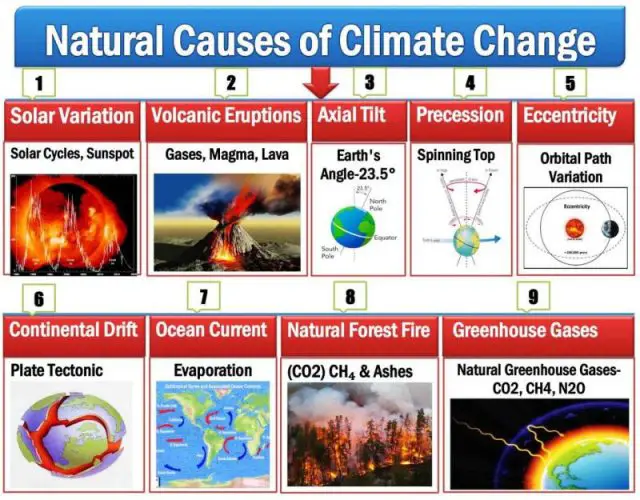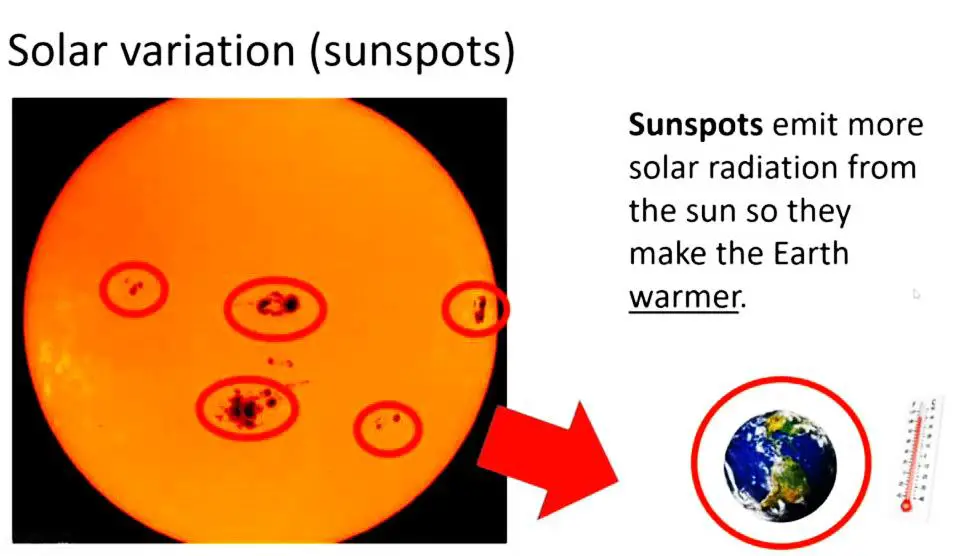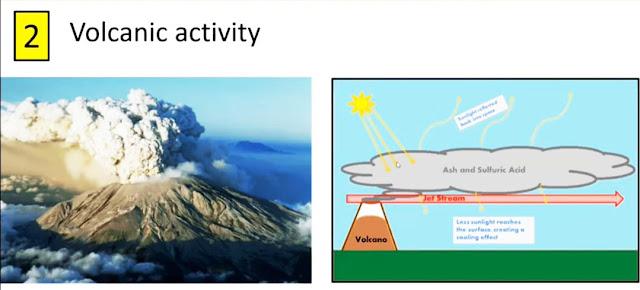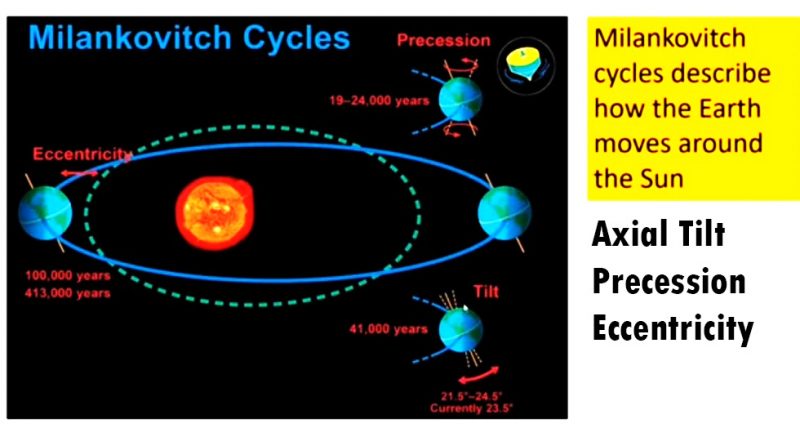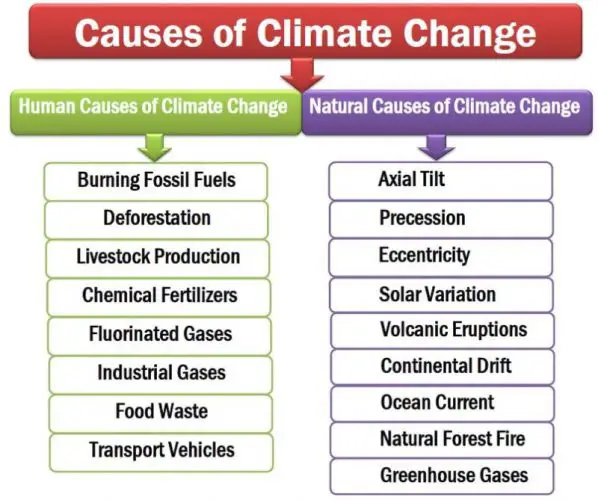Business Plan Examples For Students. Business Proposal Examples for Students. Also, Business Plan Sample pdf for Students. Business Plan Examples For Students Entrepreneurship PDF.
Business Plan
The business plan refers to the company’s written statement explaining the company’s background and business details. This plan includes the executive summary of the company, product and service, operation, marketing, and financial plan.
The employee creates the business plan to represent and improve the organization’s image to stakeholders, customers, and affiliates. It proposes the business strategy entirely mentioning how the company profits and survives in markets. So, a business plan is also known as a business proposal that is crucial for corporate branding. The business plan is essential for every company to build rapport with stakeholders and business partners as well as achieve competitiveness.
The key elements of a business plan or proposal are an executive summary, background, product and service, organizational structure, sales and marketing strategy, financial and operational plan, and more.
Business Plan Examples
A business plan example refers to a business proposal sample that thoroughly explains the business, including the executive summary of the financial statement. It is also known as a business report example or business proposal format. An example of a business plan certainly includes the executive summary of the business, operating strategy, start-up financial projections, financial projections, etc. The business plan example for students is also known as the business report format.
Business plan writing is a mandatory assignment for students in entrepreneurship. It is also a compulsory assignment for business students. The importance of a business plan is growing day by day for selling products on digital platforms and managing the organization virtually.
The business proposal is also compulsory for getting a bank loan. The organization needs it to make agreements with other organizations. The bank authority surely asks the organization to submit a business plan with the bank loan application. The other names of a business plan are business proposal, report, profile, and more. A business plan example is also known as an example of a company profile, business proposal example, sample, and format.
The Nine Components of a Business Plan are as follows:
Business Plan Examples For Student Entrepreneurship
Today, the authors present a business plan example for students. They wrote it while they were students in entrepreneurship courses at the Faculty of Economics and Management University Putra Malaysia (UPM). The lecturer sets group assignments for the students; therefore, the students make the business plan example to complete the group assignment. Thus, this business plan or proposal example for students certainly assists business administration students. It also assists students in BBA, MBA, economics, finance, and business communication courses and researchers.
The author also wrote business plan examples for students about food and an Example of Business Report.

The students set the company name “BambooS.” It sells reusable and eco-friendly bamboo straws. Straws are a unique product in Malaysia that can be customized for length and diameter. Besides, the company offers engraving services for customers. So, customers can customize a meaningful word on the bamboo straw for engraving. In addition, it provides a designed pouch as packaging for our straw that looks smart.
Business Plan Example For Students
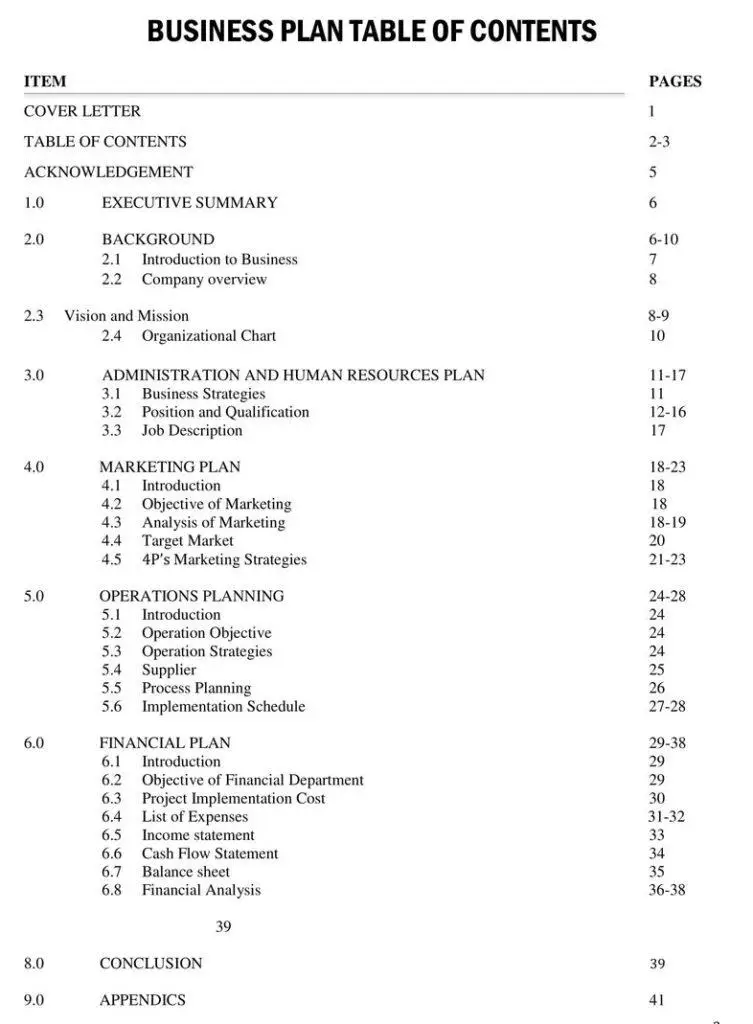
1.0 Executive Summary Of Business Plan
BambooS Sdn. Bhd. company was created by a group of 10 students in the Basic Entrepreneurship course. This company is named BambooS. It produces and sells bamboo-based products. The capital S in the company’s name stands for straw. The original idea came from a student. We chose Bamboo as the main ingredient of the products. Currently, we focus on producing eco-friendly straws to serve our customers. The products are the best quality yet affordable straws.
Our product is also biodegradable as it is made from Bamboo. We also guarantee that customers can use our products many times. It is reusable and easy to wash and carry. The straw size is customizable. So customers choose the size based on their preferences. In addition, our specialty is not only in our product but also in our packaging.
There are ten members in a group and each member will contribute RM 100. The total paid-up capital is RM 1000. We set up our warehouse in the Serdang area to produce, package, and store our products. We are making the straw as per the customer’s demand and request. For the marketing part, we are advertising and promoting our product through social media sites, such as WhatsApp, Instagram, and Facebook, and e-commerce, such as Shopee. We adopt the lean canvas business model tool to assess the outcome of the business.
2.0 Background of the Company

2.2 Company Overview
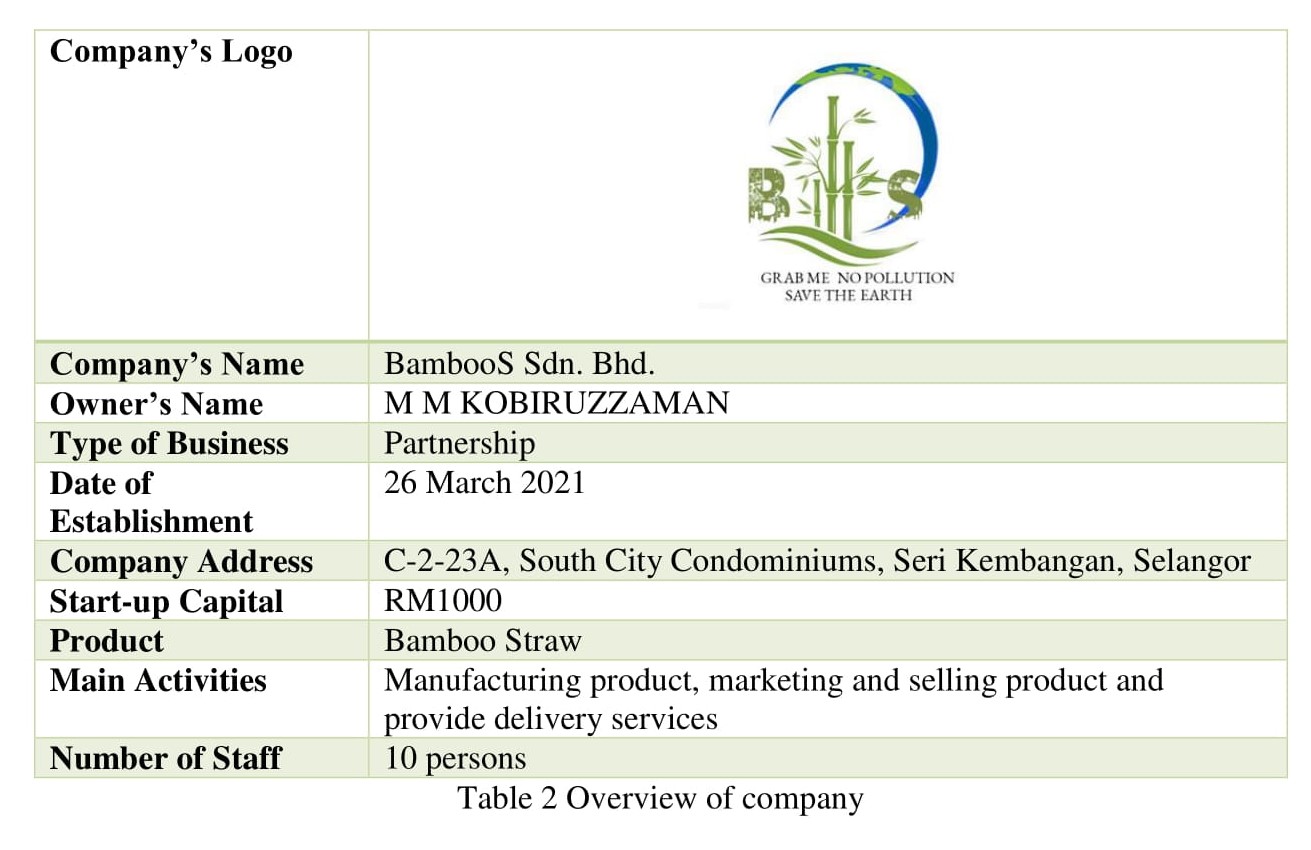
2.3 Vision And Mission Statement
2.3.1 Vision Statement
To become the most notable company in Malaysia for producing eco-friendly bamboo straws.
2.3.2 Mission Statement
We want to fulfill the objective of satisfying customers with our eco-friendly products. We want to reduce pollution by using reusable straws anywhere and anytime.
2.4 Keys To Success
The Keys to Success for BambooS Include the following:
| Reputation: | We will always keep in touch with the customer to collect all the feedback on our product or service so we can improve to reach the customer’s satisfaction |
| Superior Customer Service: | Additionally, the management helps customers in customizing and choosing the best straw size based on their preferences. |
| Location: | Moreover, BambooS delivers products all around Malaysia. |
| Product: | Finally, the products are very reusable, affordable, and eco-friendly. |
Table: 4 Keys of Success
2.5 Organizational Chart

3.0 Administration and Human Resource Plan
3.1 Business Strategies
Business strategy is crucial to maintain business growth.
The personal preferences of corporate management do not influence good business strategies. We emphasize every department’s function. It ensures the plans run smoothly to meet goals. We need to achieve them. We have put as much emphasis on the efficiency of each Department.
Our company has set several strategies to achieve the company objectives. However, these strategies have been made based on every Department’s suggestion.
a. Administration and Human Resources Department
- The admin and human resource department monitors all the business operations. It manages employees’ and management problems.
- It also solves problems that affect people management programs in the long run.
- Moreover, it follows the five-gap model of service quality to ensure service quality.
b. Marketing Department
- This department handles marketing of the product and promotional activities to reach the products to a vast amount of potential clients.
- It also promotes the business and mission of an organization through social media.
c. Operational Department
- This department ensures that all the equipment and materials are ready to run the operation smoothly. It ensures that all products are of good quality. This department follows the eight principles of TQM to ensure product and service quality.
- Additionally, this department has the ultimate accountability for profit and loss and seeks to maximize shareholder return on investment.
3.2 Management Team
3.3 Job Descriptions

4.0 Market Plan
4.1 Introduction
BambooS Sdn. Bhd. support the “Save The Earth” campaign by producing eco-friendly Bamboo straws. These straws are environmentally friendly products. Therefore, these products are alternatives to plastic straws. The government has imposed restrictions on the use of plastic straws. They also create social awareness of to use of natural products.
Hence, It is an important driving factor of our market strategy. In addition, the surging demand for drinking beverages, including juices and Boba drinks and then the Save the Turtle campaign, is also propelling the demand for bamboo straws across the globe. Bamboo straws are reusable compared to plastic; they are better for health, durable & robust, and it is an environmentally friendly product. The products will contribute to reducing global warming and preventing climate change globally.
4.2 Objective of Marketing
Our objective in producing Bamboo straws is to encourage consumers to use natural, eco-friendly products. Why are bamboo straws better than metal? Firstly, Bamboo comes from a natural source. So it is naturally sturdy and easy to collect. We do not need to use chemicals to make straws.
Additionally, metal straws are not pocket-friendly compared to Bamboo. Moreover, metal will rust when in contact with water and oxygen. Bamboo stock is much cheaper, less work, and easy to collect. Our marketing strategy will focus mainly on reusable principles which are much more trendy to youngsters because we have an engraving service to attract them.
4.3 Analysis of Marketing
4.3.1 Market Trend
The demand for bamboo straws has risen due to growing environmental attention. Additionally, plastic straws have been reduced due to state restrictions. However, the bamboo straw market is expected to achieve high growth shortly. In addition, BambooS Sdn. Bhd is a unique company in Malaysia. We produce our straw ourselves, and we provide safety and hygiene assurance. The buyer can engrave their name on the straw. Nowadays, customers want recognition for something they buy or support. They are also sincere about ‘Save the Earth’ and deserve to flex.
4.3.2 External Environment Analysis
Our first demographic psychographic and geographic target market is the University Putra Malaysia (UPM). Since we are students of UPM, it is easier to approach our target customers, including students and staff. Students tend to bring their water bottles or flasks to classes. It is one step toward being environmentally friendly; thus, we promote their effort by selling bamboo straws. In addition, we will promote our product at cafes or food courts at the faculty and library. We also establish a booth at super shops.
4.3.3 Internal Environment Analysis
(SWOT ANALYSIS)

4.3.4 Market Opportunities
Our bamboo straw comes with a pouch; thus, it is hygienic and easy to bring everywhere. We also provide a small brush to ensure deep cleaning of the inner straw. Our product can be used again and again. So students and staff can save money. They do not need to bring straws in large volumes. The structure of our bamboo straw is strong and sturdy; thus, it will not break if soaked in water for a long time, unlike paper straws.
4.4 Target Market
4.4.1 Segmentation
Size
- S size is fit for ordinary drinks, fully liquid
- L size is suited for Boba drink or any drink that has topping.
Usage
- People use straws for drinking tea, juice, frappe, and Boba.
Industry
- Restaurants, cafes, food court, canteen, food stalls, super shops around UPM
4.4.2 Consumer Market and Buyer Behaviour
(i) Students and staff at UPM
(ii) Cafe and Restaurant at UPM
4.4.3 Positioning
- New business strategy for eco-friendly products in the market.
- Our production, process, and packaging materials match zero pollution.
- Providing Engraved service
- Customized and Eco-friendly bamboo straws of different sizes
- Made of organic material
- Unique punch made by the jute bag.
4.5 4 P’s Marketing Strategy
4.5.1 Product Strategy
To make our product unique, we ensure the quality and safety of our products always satisfy our customers.
Packaging
Our product comes neatly packaged in a unique eco-friendly punch. It is made of a jute bag. The natural bag is designed to make people use bamboo straws every day.
Labeling/Customised
Our company provides customized products. We resize and engrave the bamboo straws to attract more customers. So, our customers can request any size and imprint their straw with any logo or design they like. Our product comes in two sizes: the regular size for the standard drink, fully liquid, and the large size for the Boba drink or drink that has topped. Customers can send us their logo or name on social media sites. Personalized bamboo straws look fantastic across social media.
4.5.2 Price Strategy
Price is the payment given by one party to the other to get the return for goods or services. It is necessary as it determines our profit and business survival. Two factors affect our pricing strategy to increase our profits. The internal factor that affects our pricing strategy is production and management cost. At the same time, the external factor is the competitive environment.
Our management team decided to sell the straw in four sets: A, B, C, and D. Our company decided to set the price at RM 10.00 for set A. This set includes the common Bamboo straw, brush, and pouch. Then SET B cost RM 12.00, including the Boba size straw, brush, and pouch. SET C and SET D are more special because they include the engraving service. The engraving cost is RM 8.00 for each Set. As we mentioned before, we resize products for clients. So our customers can personally request to resize the straw. We charge it costs RM 9.00 per set.
4.5.3 Place Strategy
Place strategy is also known as distribution strategy, wherein the organization decides the mode of distribution for the product. The pacing strategy plays an important role in selling the products. We have chosen the market, cafe, or restaurant adjacent to the University Putra Malaysia. Our main target market is UPM staff and students.
Furthermore, we also decided to make it easy for our customers to find our product by using the shopping app, Shopee apps. We chose these apps because Shopee is the best option if you want to start selling online at a low cost and big money.
4.5.4 Promotion Strategy
Promotion is the advertising process to provide information to different parties about the products. It is a communication process that influences the customer to buy products. To get customers’ attention and obtain a more significant market share, Bamboos Sdn. Bhd uses digital and internet marketing.
We have set up social media accounts, Instagram, Facebook, Shopee, and Blogspot, to promote our business. The marketing team will upload the promotional content to social media sites. This is because most people stay on social media sites mostly. With that, social media sites are the easiest way to buy anything we want without going out. Moreover, online shopping has become popular in this era, and all these social media sites have become the hottest sites, especially Instagram, which has a high rating in advertisements. Many companies use social media to sell their products and services by putting corporate information in their accounts.
Social Media Advantages
Social media are free sites where we can reach a large number of customers. Hence, we use social media to do hard and soft selling.
We fully develop every post to attract customers. In addition, we will always update our posts and story feeds. We ensure that customers are more exposed to our product. Next, we also use social media hashtags. We use hashtags such as #Bamboos, #SafeTheEarth, and more to make it easier for customers. The marketing team uses social media for the ordering process.
Similarly, we will place the generated links on each social media to encourage the product ordering process. Our company also makes sure transactions with our customers are easy. Finally, we also produce videos to promote our sales. The video will achieve the highest social media reach for views and engagement.
We tend to focus more on WhatsApp groups, Shopee, and Instagram since our target audience is UPM students. Many students are involved in WhatsApp groups, such as on faculty, college, hostels, and clubs. WhatsApp and Instagram are more popular among students as the places they spend most of their time. WhatsApp is the most popular social media site in Malaysia.
5.0 operations planning
5.1 Location and Address
We will mainly sell the straw on social media sites. The production team will handle the production process. They resize and wash the Bamboo at the warehouse in Selangor, Malaysia. The social media sites are Instagram, Facebook, Shopee, Blogspot, and WhatsApp. Supplies will be directly delivered to the responsible members for further processing based on our buyer’s order.
5.2 Objective of Operations
We aim to produce and deliver good quality Bamboo Straw. Our team ensures that all products are effective and attractive. We also must gain customers’ trust and happiness with our service, including price and delivery. We also make sure our products are cleaned and safe for use. Our team is very responsive to making good-quality straws. In addition, our company has ultimate responsibility for profit and loss. However, we seek partners for more investment.
5.3 Operation Strategies
A few strategies have been set up to ensure that our business runs smoothly throughout the week and meets our objectives.

5.4 Supplier
The bamboo stock was from a supplier via the Shopee platform, and the pouch supplies were from Giftstalk Sdn. Bhd. The company logo’s printing service was also included when we ordered the pouch from suppliers. Moreover, we order coconut fiber cleaning brush stock and packing Boxes from Shopee. We also surveyed purchasing and made sure that our supplies were reasonable. All the supplies are ordered online and delivered to our company via specialized courier service companies.
The bamboo straw will be customized and delivered to the customer using J&T Express, Ninja Van, and cash-on-delivery service, which will ease our delivery.
Thus, we have decided on the following suppliers as our supply providers:
- Wing.DIY –Shopee- For Bamboo Stock
- GIFTSTALK SDN BHD)- For Pouch Supplies
- Gd. Pack -Shopee)- For Paper Boxes Stock – Sandpaper Holder with Plastic.
5.5 Process Planning

5.6 Implementation Schedule

5.7 Machinery and Equipment Including GST

6.0 Financial Plan
6.1 Introduction
A financial plan can be defined as a process of framing procedures and budgets regarding the financial activities of concern. This is done to ensure good financial and investment procedures.
Generally, the financial plan is used to know an investor’s current pay and future financial state by using current known variables to predict future income, asset values, and withdrawal plans.
A financial plan is one of the most crucial parts of a business. Some of the importance of a financial plan are:
- A financial plan provides the direction of one’s business.
- It also helps understand how finances impact one’s business.
- Additionally, it helps to manage income better.
6.2 Purpose of the Financial Department
A few purposes are as below:
- Firstly, it determines capital conditions.
- Secondly, it operates the fund nicely for different purposes.
- Finally, it maintains proper cash flow.
6.3 Project Implementation Cost

Source of Fund
Our money is used as the start-up capital with a contribution of RM100.00 per shareholder, bringing the total investment to RM 1000.00.
6.4 List of Expenses
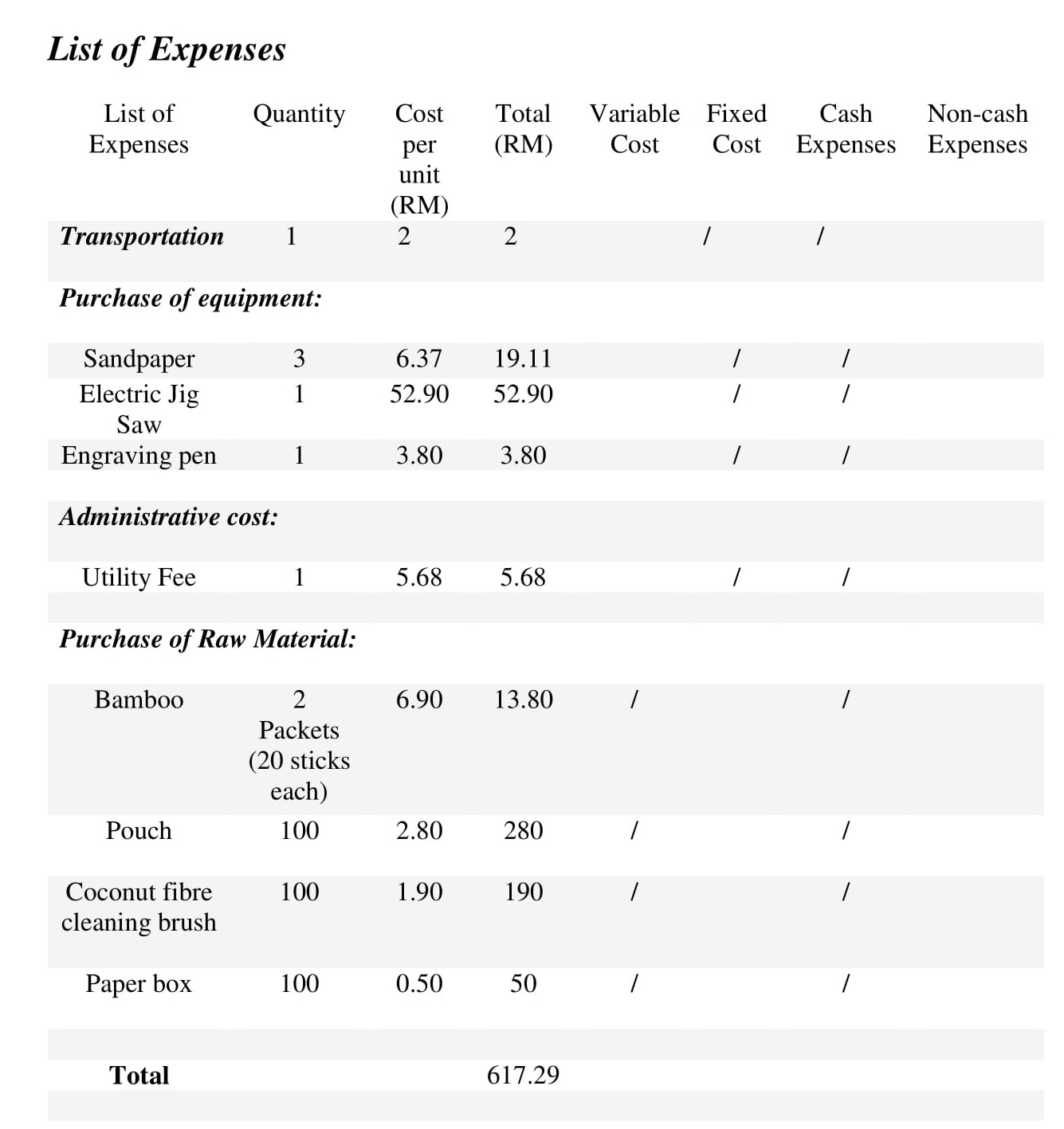
Twelve partners funded a total of RM1000.00 to cover all business costs, which is RM 617.29. Expenses are in terms of buying raw materials, equipment, and delivery fees. We will not invest all amount to the business.
The equipment is counted as fixed cost as they are bought in bulk. Refer to 6.4 (List of Expenses) for detailed information.
6.5 Record of List of Sales

6.6 Income Statement
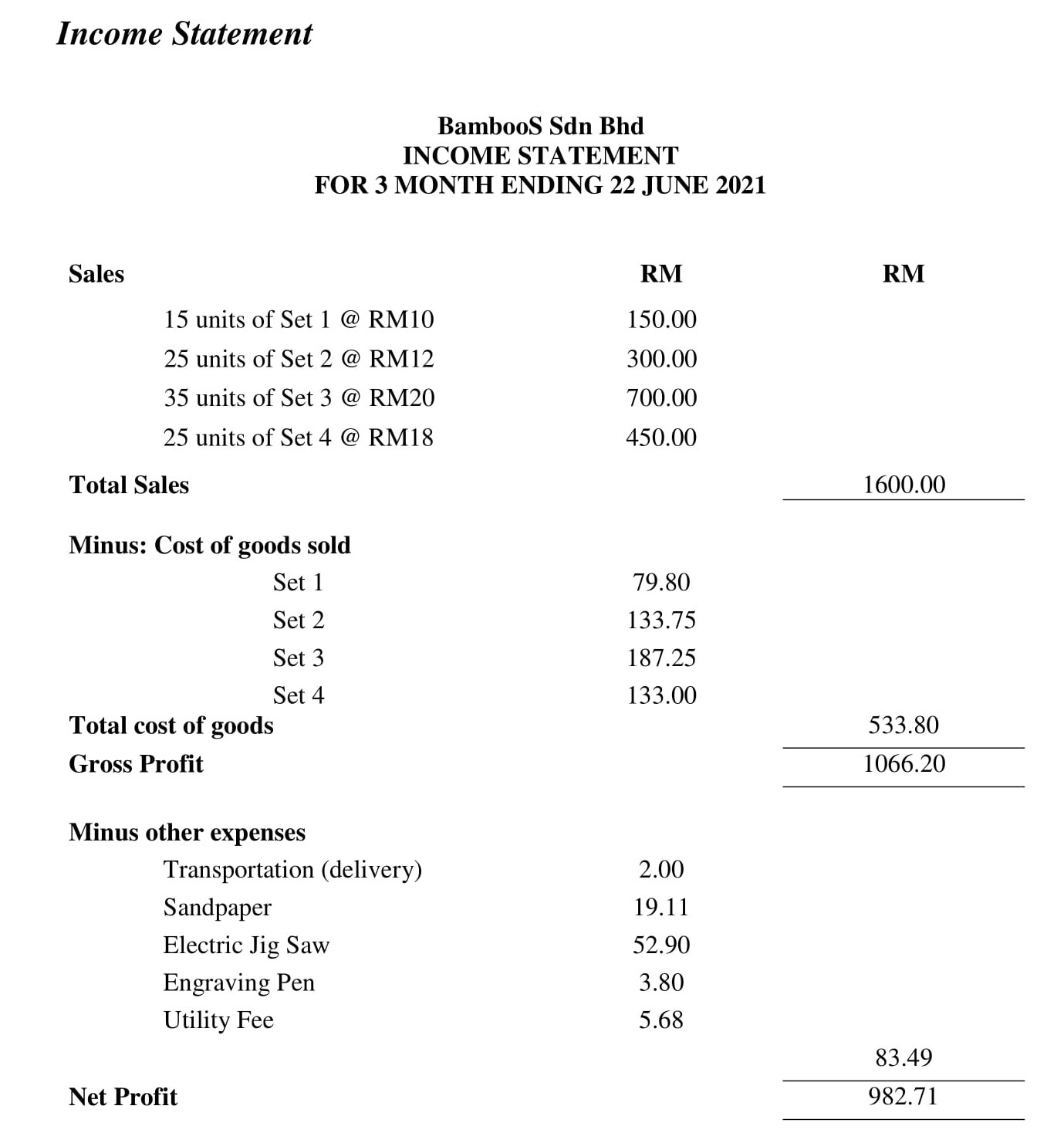
After one month of business, BambooS ended up with RM 1600.00 from 7 different products. This includes selling 15 units of Set 1, 25 of Set 2, 35 of Set 3, and 30 of Set 4. Leftovers for bamboo straws are found. The income statement shows that the business’s net profit after one month of operation is RM 988.39, approximately 98.8% of capital invested into the business.
6.7 Cash Flow Statement
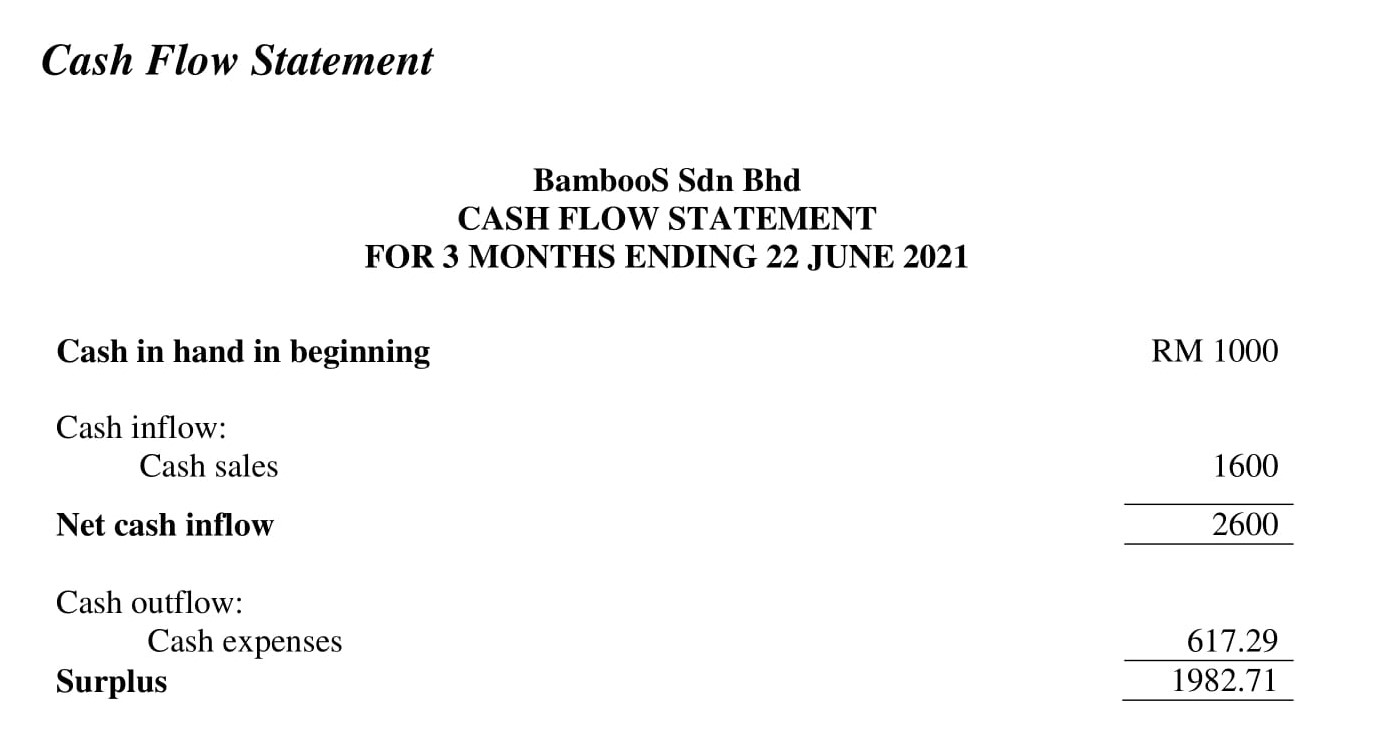
The case flow statement shows that the initial capital on hand is RM 1000.00, and at the end of the business, the total surplus (after deducting all expenses) is RM 1982.71.
The RM 1982.71 includes RM 100 capital invested by every shareholder at the beginning of the business. By dividing the remaining money after deduction, each shareholder would find themselves receiving an extra RM 98.27. Hence, every
6.8 Balance Sheet

At the start of the business (22 March 2021), the initial capital share is RM 300.00. There is no liability such as a loan.
At the end of 9 weeks’ business (22 June 2021), the cash on hand increased to RM 1982.71, as well as the owner’s equity. The firm’s net worth is RM 1982.71, done by subtracting liabilities from assets.
6.9 Financial Analysis
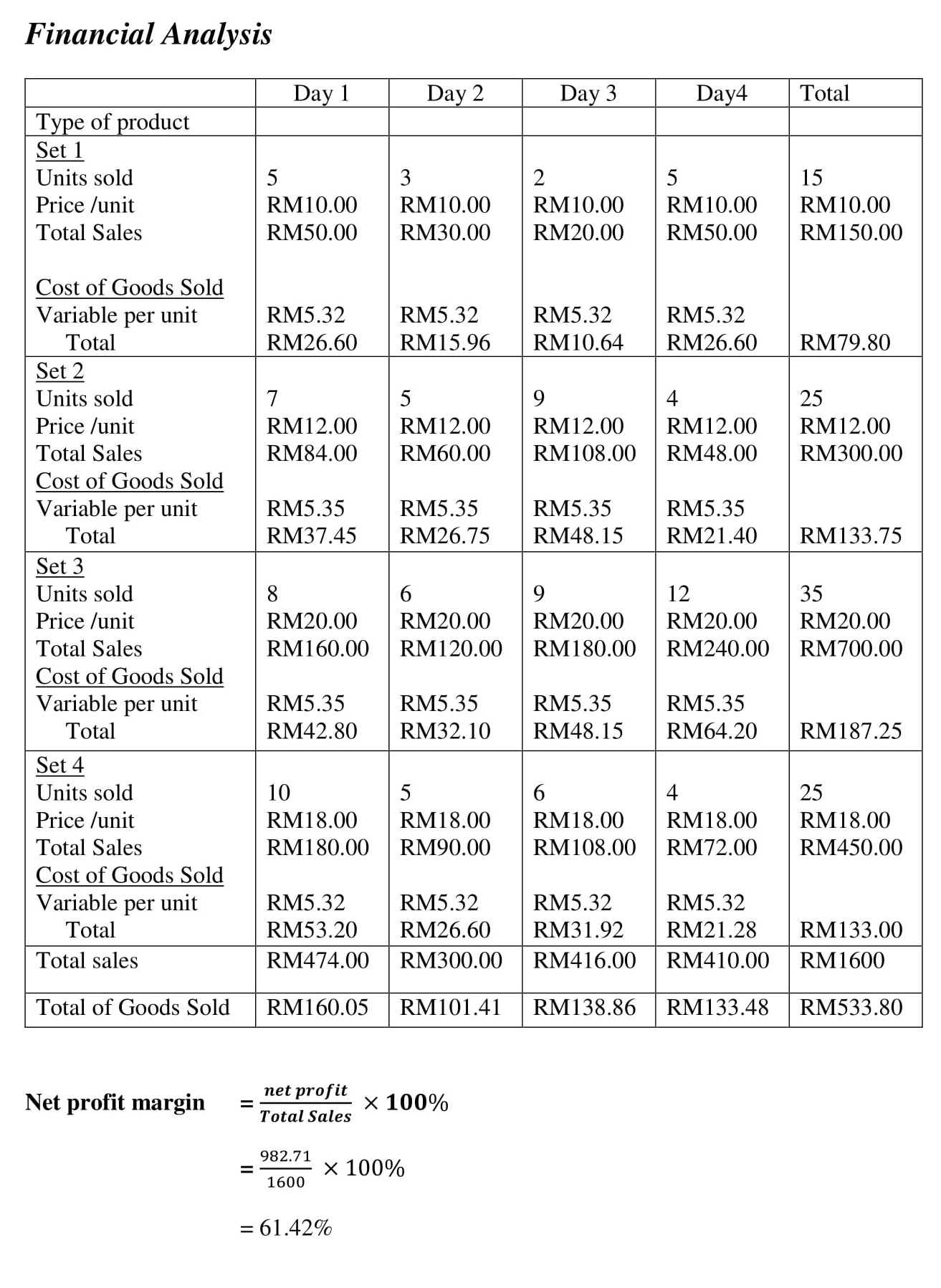

BambooS has a net profit margin of 61.42%. BambooS also has a break-even point of RM 126.50. Sales passing this break-even point means that BambooS can start making profits.
Set 1 has a break-even point of RM 11.90, and set 2 have it at RM 23.72. The break-even point for set 3 is RM 55.34, while set 4 has a break-even point of RM 35.58.
The interest for the business is 0.9827 or 98.27%. This means for every RM 1 capital invested in the business; the shareholders can get back RM 0.98 as profit.
7.0 Conclusion
Based on the business plan template or business proposal example that we have made, BambooS will give us profitable returns. The assumptions we made for these three months are conservative as we know that our company is still in the beginning, and the marketing and promotion are still in the early phase. The company sets systematic planning to reach the target. Thus, BambooS is very confident that our company will be able to grow in the future and become the most popular brand in the world.
We will always ensure that everyone in the company cooperates well to achieve the business target profit. We hope that BambooS will be the best company for producing eco-friendly straws in Malaysia. Our company assists UPM students and staff in reducing plastic usage.
Problem Faced and Solutions in Business
Every business will need to face many challenges to sustain success. As a new business, we also must face many things to achieve our business goal.
Firstly, we confirmed the product we would sell; everyone gave their opinions and ideas. This leads to 10 different products and services on the list. So we need to vote for the best one. We had faced a healthy argument on picking the best product. After discussion, we finally came out with the idea of producing an eco-friendly product. We focused on global warming issues and finally decided to produce and sell bamboo straws.
Moreover, we also have to face a conflict in fixing the vendors. We need to find the best vendors that offer the most reasonable price for us to produce the bamboo straw. The cost must be tele with our starting capital. To solve this, everyone has done their research on all the possible suppliers until we find the best one to choose from.
To avoid extreme market competitors, our team chose a blue ocean strategy to create a new market to achieve competitive advantages.
Business Proposal Examples For Students PDF
A business proposal is a short business plan. The business proposal describes the business process. However, a business proposal includes an executive summary, problem statements, product, finance, and solution. The example of a business proposal for students certainly guides others to create a business plan. This business plan sample teaches how to write business plan assignments for students. Students might learn how to write a simple business plan and proposal.
The importance of a business plan is crucial to stakeholders, employees, students, and entrepreneurs. Additionally, the business plan example assists employees in creating a professional business proposal.

